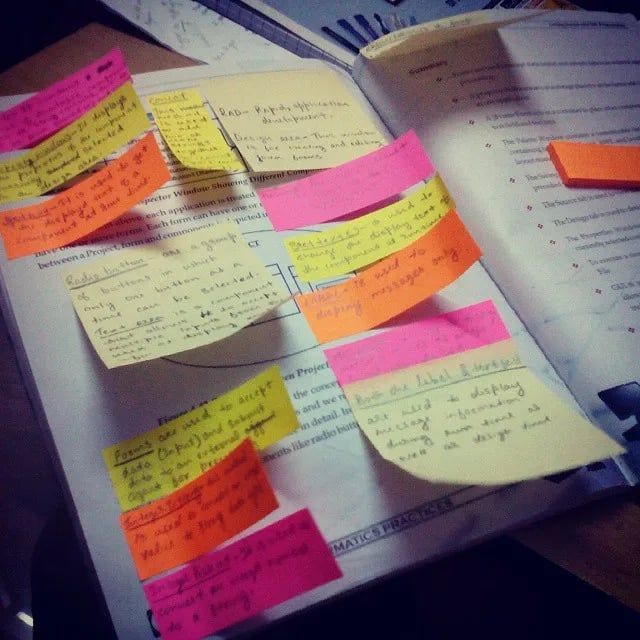Bookmarks are the key to organizing our thought as embodied in the web — and a stepping stone to the web-enabled mind.
Making our mark on our world is arguably among the most important activities we can undertake. The drive to make our mark on this world is underpinned by our most passionate hopes. It affords us the promise of being able to be proud, saying to the world, “look, here’s what I did!”.
But making our mark serves another purpose too. It provides guidance for us in that it serves as a reminder for where we’ve been, where we are, and here we want to go.
We write lists of our goals, write diaries containing our innermost secrets, and highlight text we might need for an upcoming exam. It’s a very personal activity, and involves reorganizing and tagging the world to represent how we understand and feel about it. It reflects a complex array of phenomena in our mental state — our thoughts, perceptions, and feelings.
Perhaps that’s why, when Google changed the structure of its bookmarking application on Chrome recently, the outrage was palpable on Google’s forums:
“HATE — HATE — HATE the new format.”
“I HATE THE NEW BOOKMARKS setup. It is dam horrible and I hate it..I want the old bookmarks setup back. Why did they have to go and change it in the first place???? What a bunch of dam idiots”
“The new “bookmark management experience” is dreadful. Sack the design team or give them all a large decaf latte mochachino and set them free.”
But really this much outrage? Why are bookmarks so utterly important to people?
Well, first it’s important to note that all of the activities noted above — writing lists of goals, writing in your diary, highlighting text, and yes, bookmarking, are forms of what is known as external cognition. External cognition is the process of altering our environment to help us remember and think. When we scribble on a book we are etching marks on to the world to remember certain information and what we thought of that information. All of this is a form of cognition — we impress ourselves upon our environment to remind us and relieve us of the task of remembering.
There’s no doubt this activity is enormously important: we are creating our own cognitive world outside of our head, and when our cognitive world is rearranged without our consent, we doubtlessly get angry. We are out of sync with our cognition, and from the perspective of our ego, the mark we made on the world has been erased.
Given the importance of this phenomena, it’s a wonder why bookmarking advances are glacial and uncreative in their development. We largely use the same system as existed in the mid-1990s. Perhaps it is because developers and designers don’t want to alter systems that are, as noted, so precious to users.
However, I posit this lack of innovation is because the focus on information interaction development is on either the aesthetic design of information or the “feeding” of information, but not on affording the personal restructuring of information.
Think about it — information design has advanced immensely. Javascript, HTML5, CSS, high bandwidth and powerful graphics processing provides us with websites that are astronomically different from those in 1995.
Information feeds, the automatic curation of incoming content, too, have vastly advanced in 20 years. Numerous technologies have come (and gone) RSS, Tumblr, Facebook,. Twitter and any .ly adverb you can think of.
Yet bookmarks, the placement of our marks on websites has not been a priority in the same way at all. Certainly tools to create, comment sections, and dynamic pages have all advanced our ability to interact and communicate, but the ability to construct personalized maps of web content through forms of advanced bookmarks is non-existent.
This tragedy, this inability to structure information we’ve seen (and placed value on) in our own way, results in users slowly eking out primitive patterns of structuring their information by using the same folder and file system developed decades ago. No semantic, thematic, visual or other types of relationships are allowed — either through automation or manual activity. Tags and filters are used by some third-party bookmarking applications, but they are extensions to browsers, drain system resources, and are hardly creative in their own right. The solutions, few that there are, are unacceptable.
It’s hard to over-emphasize the importance of advancing our ability to formulate our digital world, our external cognition, in a way that best reflects our mental processes.
Any interaction designer worth her salt will tell you that the best interactive systems begin not with a focus on creating an interactive system, but rather with a focus on requirements for a user activities. So too is it with information interaction.
Information interactions must not focus on what it is those involved in the website creation business want the user to focus on, but rather how the user aggregates and parcels websites within his memory. A 1:1 match of the relations, the labels, and the organization between bookmarked websites and users’ internal cognition must be a target for those in the development of bookmarking managers.
Bookmarks help us remember, yes, but given the utterly overwhelming amount of data we use — or want to use — they must also reflect how we understand and feel about our personal universe. Our own personal ontology, at our fingertips, both reminding and reflecting, will drive up our efficiency and effectiveness, and provide an important step in closing the gap to a web-enabled mind. After all, how could we make an effective mark on the world if we can’t make an effective mark on our own world?
You just read issue #1 of DisAssemble. You can also browse the full archives of this newsletter.
